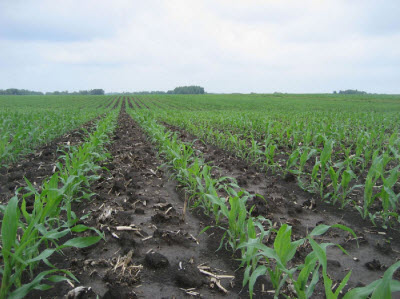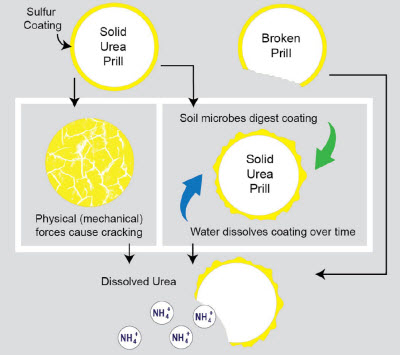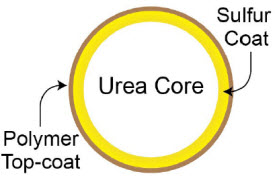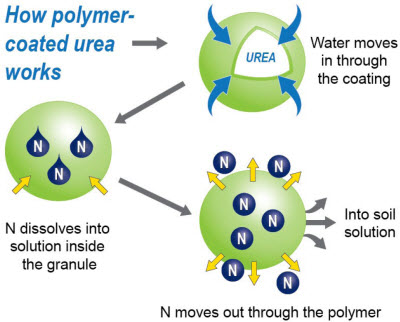Controlled-Release Nitrogen Fertilizers (Crop Insights)
|
- Controlled-release nitrogen (N) fertilizers include coated ureas, noncoated "chemical-release" forms and other products.
- These fertilizers can reduce N losses by delaying the initial supply of N and providing it gradually to the developing crop.
- Sulfur-coated urea releases N as it slowly degrades by microbial, chemical and physical processes. An additional polymer coating may be applied to better seal the granule.
- Nutrient release from polymer-coated urea is controlled by the properties of the coating material (i.e., its permeability characteristics as affected by temperature and moisture).
- Chemical controlled-release products are made by reacting urea with aldehydes to form fertilizers with low solubility or other properties for specific crop uses.
- Controlled-release products may be most useful in high-value crops, environmentally sensitive areas, fields highly susceptible to N losses or with limited opportunities for repeat applications, contest plots, and foliar applications.
Introduction
In North America, N fertilizer is largely applied as
anhydrous ammonia, UAN solutions or urea. However, these forms of N can
be lost if adverse (primarily wet) weather conditions precede their
uptake by crops. Controlled-release N fertilizers can reduce these
losses by delaying the initial release of N and providing it gradually
to better match its availability with crop uptake needs.
Controlled-release (also called slow-release or delayed-release) N
fertilizers include coated ureas, noncoated "chemical-release" forms and
other products. This article discusses controlled-release N fertilizers
and how they function to reduce N losses.Coated Ureas
Coating urea prills (granules) with a water-insoluble, semipermeable, or impermeable (with pores) material delays the release of N from the urea. Urea is highly soluble in water, but the solubility of coated urea is dependent on the coating material, its thickness, and the coverage and uniformity of the coating on the granule.Materials used for urea coating or "encapsulation" include sulfur, polymers or both. As the urea is gradually released from the coated granule, it is exposed to the same chemical and biological processes as noncoated urea (see previous Crop Insights on Common Nitrogen Fertilizers and Stabilizers for Corn Production, Butzen, 2013).
 |
| Figure 1. N-sufficient corn field at V5. Most N is applied for corn well ahead of the period of peak crop uptake (V8 to tasseling). |
The additional labor and equipment required to produce coated fertilizers and the cost of the coating materials make them much more expensive than conventional N fertilizers. Due to the simplicity and relatively low cost of using sulfur as a coating material, sulfur-coated urea has become the most commonly used coated-urea product.
The Tennessee Valley Authority (TVA) developed the basic production process for sulfur-coated urea over 50 years ago, so the product is familiar to most farmers who use urea. This fact and the high N content of the product (30% to 40%, depending on the amount of sulfur applied) have added to its popularity among coated products. In addition, as a generic product, its cost has remained relatively low.
The sulfur coating is an impermeable layer that slowly degrades through microbial, chemical and physical processes (Figure 2). The completeness of the coating determines its effectiveness; incompletely coated or cracked prills are immediately amenable to dissolution in soil water and hydrolysis by urease. Because not all granules have complete integrity of their sulfur coating, some N is quickly made available to the soil solution. In fact, the "7-day dissolution rate" is routinely as high as 30% and may be as high as 40% to 60% of the total N content of the product in some cases. With such high rates of dissolution, a rapid initial effect on the crop would be expected (Trenkel, 2010).
 |
| Figure 2. Breakdown of sulfur-coated urea. Adapted from Blaylock, 2010. |
 |
To help solve the problem of irregular nutrient release from sulfur-coated urea, a class of "hybrid" products has been developed. These products include a thin polymer coating on top of the low-cost sulfur coating. This has the benefits of reducing the overall cost vs. that of polymer-only products, while providing a better seal than the sulfur-only products. Polymer-Coated Urea
Polymer-coated urea fertilizers use a hydrophobic (water insoluble) coating that temporarily isolates the urea prill from the soil environment. These polymer coatings may be resins or mineral-based products that act as semipermeable membranes or impermeable membranes with tiny pores. Nutrient release through these membranes is controlled by the properties of the coating material, i.e., its permeability characteristics as affected by temperature and moisture (Figure 3). Thus, they are not significantly affected by soil properties such as pH, salinity, soil texture, microbial activity, re-dox potential or cation exchange capacity. Therefore, it is possible to predict and control the nutrient release rate from these products more accurately than for sulfur-coated ureas (Trenkel, 2010).
Chemical Controlled-Release Products
 |
| Figure 3. Release of N from polymer-coated urea. Adapted from Blaylock, 2010. |
Urea-Formaldehyde / Methylene Urea: By reacting urea with aldehydes, compounds with high molecular weights and complex chemical structures with low water solubility can be created. These products release their N slowly by gradually dissolving in soil water, decomposing by microbial activity, or both.
Reacting formaldehyde with excess urea under controlled conditions results in a mixture of methylene ureas with different polymer chain lengths. By changing the manufacturing conditions, the chain lengths, solubilities and N release rates can be varied. The release pattern is also influenced by soil temperature and moisture and by soil microorganisms and their activity (Trenkel, 2010).
Urea-Triazones: These compounds are produced by reacting an aldehyde and ammonia (or primary amine) with excess urea in an aqueous medium under controlled conditions. The resulting liquid fertilizer is a stable solution containing N from both triazone and unreacted urea. Products containing triazone-N remain in a liquid phase on plant tissue surfaces longer than some other urea-based products. These products have also proven safer to plant foliage than urea and UAN solutions in research studies (Clapp, 2001). Consequently, they are often used as foliar fertilizers.
Available Controlled-Release Products
A number of controlled-release N products are now available to row-crop producers in the U.S. or Canada (Table 1).| Table 1. Controlled-release N products available in North America (adapted from Hergert et al., 2011) |
||||||||||||||||||
|
||||||||||||||||||
| 1 A urease inhibitor (active ingredient in Agrotain® products). 2 A nitrification inhibitor (active ingredient in Guardian |
Possible Uses of Controlled-Release Products
The higher cost of controlled-release products generally excludes their use in cases where conventional N fertilizers can perform the same function adequately. Most growers of commodity row crops who use controlled-release products likely apply most of their crops' N needs with conventional products and only use controlled-release products to supplement their primary N fertilization program. Controlled-release products may be most useful when:- Growing a high-value crop (e.g., a seed crop)
- Applying on fields subject to high losses of N, for example:
- light-textured, leachable soils
- low-lying, heavy soils at risk of ponding and denitrification losses
- Applying in a regulated watershed
- Applying in a field that borders a stream, river, lake, etc.
- Applying in fields with limited opportunities for repeat applications due to expected weather patterns, field / crop conditions, distance, or labor / equipment issues
- Applying urea to the soil surface but not incorporating
- Foliar/remedial applications
- Application to contest plots to ensure constant N supply
References
Blaylock, A. 2010. Enhanced efficiency fertilizers. Colorado State University soil fertility lecture, 10-20-2010. Agrium Advanced Technologies, Loveland, CO.Butzen, S. 2013. Common nitrogen fertilizers and stabilizers for corn production. Crop Insights vol. 23 no. 2. DuPont Pioneer, Johnston, Iowa.
Clapp, J. 2001. Urea-triazone N characteristics and uses. Proceedings of the 2nd International Nitrogen Conference on Science and Policy. The Scientific World (2001) 1(S2), 103-107. ISSN 1532-2246; DOI 10.1100/tsw.2001.356.
Hergert, G., R. Ferguson, C. Wortmann, C. Shapiro and T. Shaver. 2011. Enhanced efficiency fertilizers: will they enhance my fertilizer efficiency? Proceedings of the 3rd Annual Crop Production Clinics, University of Nebraska-Lincoln Extension.
Trenkel, M. 2010. Slow-and controlled-release and stabilized fertilizers: an option for enhancing nutrient use efficiency in agriculture. International Fertilizer Industry Association, Paris, France.
Didn't know urea is coated as well!
ReplyDeleteThanks for sharing this
Elcometer 500
Thanks for providing such useful information on the coated fertiizers. Great article. I am working in a company which is a manufacturer of fertilizer coating material. And Really this company offering the best quality products to its customers. For more information you can visit: NAQ Global.
ReplyDeletefertilizer coating material
Defoamer Chemical Suppliers
Filter Aid Powder Manufacturers
Ashwini Industries is a trusted leader among Acid Black 2 Manufacturers, delivering high-quality dyes for various applications. As reliable Antifoaming Agent AI-010 Manufacturers, we ensure superior performance solutions. Our expertise extends to being premium Styrene Acrylic Emulsion Manufacturers, catering to diverse industrial needs. Additionally, we are recognized Vat Paste Manufacturers and Fluorescent Pigment Paste Manufacturers, providing top-tier products for the dye and pigment industry.
ReplyDeleteNice Post!!
ReplyDeletePlease look here at Granular Sulfur
Nice Post!!
ReplyDeletePlease look here at Polestar Fertilizers